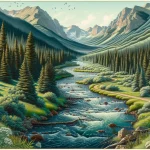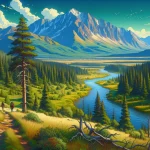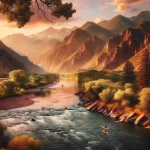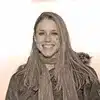The East Fork San Juan River, located in southwestern Colorado, is a renowned fly fishing destination renowned for its diverse aquatic life and stunning natural scenery.
In This Article
TL;DR
- The East Fork San Juan River offers world-class fly fishing opportunities for rainbow trout and other species.
- The river's unique geography, including logjams, boulders, and deep pools, creates ideal habitats for fish.
- Conservation efforts and environmental data monitoring help preserve the river's ecological integrity.
Destination Overview
The East Fork San Juan River winds through the picturesque landscapes of Mineral and Archuleta Counties in Colorado. This tributary of the San Juan River attracts anglers from around the world, drawn by its exceptional fly fishing opportunities and breathtaking natural beauty. The river’s crystal-clear waters, teeming with rainbow trout and other fish species, provide a challenging yet rewarding experience for both novice and seasoned anglers.
Consider the East Fork Campground at Gunnison National Forest in Gunnison County, Colorado, for a convenient camping option. Situated near the San Juan Mountain area, the East Fork Campground offers proximity to the East Fork San Juan River, either by a short drive or accessible hiking trails from the site.
Colorado Fly Fishing
Colorado is renowned for its world-class fly fishing, and the East Fork San Juan River is a prime example of this reputation. The river’s diverse aquatic ecosystem supports a healthy population of rainbow trout, making it a sought-after destination for San Juan River fly fishing enthusiasts. Anglers can employ various techniques, including dry flies, nymphs, and streamers, to target these prized fish.
The river’s streamflow patterns and seasonal variations influence fishing conditions, requiring anglers to adapt their strategies accordingly. Consulting USGS water data and local expertise can help anglers time their visits and select the most effective tactics for the prevailing conditions.
Fishing Techniques and Tackle
Successful fly fishing in the East Fork San Juan River requires a combination of skill and the right tackle. Dry fly fishing, where artificial flies mimic insects on the water’s surface, is a popular technique during hatches and when fish are actively feeding on the surface. Nymphing, which involves fishing with weighted flies that imitate aquatic insects in their nymph stage, is effective when fish are feeding subsurface.
For those seeking a more aggressive approach, streamers, which imitate baitfish or other prey, can be an exciting option. Experienced anglers often employ a variety of techniques and adjust their tackle accordingly, ensuring they are prepared for the river’s ever-changing conditions.
River Geography and Structure
The East Fork San Juan River’s unique geography plays a significant role in shaping its fishing experience. The river’s structure, characterized by logjams, boulders, pocket water, and deep pools, creates diverse habitats for fish. Understanding these features is crucial for anglers to identify prime fishing spots and navigate the river effectively.
Logjams and boulders create eddies and current breaks, where fish often hold and feed. Pocket water, formed by the river’s meandering course, offers ideal conditions for dry fly fishing. Deep pools, on the other hand, provide refuge for larger fish and can be productive when fished with streamers or nymphs. Be sure to bring your fly reel as well!
Aquatic Biodiversity
While rainbow trout are the star attraction, the East Fork San Juan River boasts a diverse array of aquatic life. This biodiversity not only enhances the river’s ecological significance but also contributes to its appeal for fishing and environmental studies.
Conservation efforts by local organizations and government agencies aim to maintain the river’s biodiversity and protect its delicate ecosystem. Anglers play a crucial role in these efforts by practicing catch-and-release techniques and adhering to regulations designed to ensure the sustainability of fish populations.
Surrounding Areas and Tributaries
The East Fork San Juan River is part of a larger network of waterways that includes tributaries like Wolf Creek, West Fork San Juan, Quartz Creek, and others. These interconnected systems contribute to the river’s overall ecosystem and offer opportunities for extended exploration and recreational activities.
Venturing into the surrounding areas and tributaries can provide anglers with a deeper appreciation for the region’s natural beauty and diverse landscapes. From hiking trails to campground spots, these areas offer a wealth of outdoor experiences that complement the exceptional fly fishing opportunities found on the East Fork San Juan River.
Conservation and Environmental Data
Preserving the East Fork San Juan River’s ecological integrity is a priority for local communities, forest service, and conservation organizations. Environmental data, such as USGS water data, plays a crucial role in informing conservation strategies and river health management efforts.
By monitoring factors like streamflow, water quality, and habitat conditions, stakeholders can make informed decisions to mitigate threats and implement sustainable practices. Collaboration between anglers, local residents, and environmental agencies is essential to ensure the long-term preservation of this natural treasure.
FAQ
What is the best time of year to fish the East Fork San Juan River?
The prime fishing season on the East Fork San Juan River typically runs from late spring through early fall. However, the specific timing can vary depending on factors like streamflow, insect hatches, and weather conditions. Consulting local guides or monitoring USGS water data can help anglers plan their trips for optimal fishing conditions.
Are there any special regulations or permits required for fishing on the East Fork San Juan River?
Yes, anglers are required to obtain a valid Colorado fishing license and adhere to the regulations set by the Colorado Parks and Wildlife. These regulations may include catch limits, gear restrictions, and designated catch-and-release areas. It’s essential to familiarize yourself with the current regulations before planning your fishing trip.
What kind of accommodations are available near the East Fork San Juan River?
The towns of Pagosa Springs and South Fork offer a variety of accommodations, ranging from rustic cabins and campgrounds to hotels and resorts. Many of these options cater specifically to anglers and outdoor enthusiasts, providing convenient access to the river and surrounding areas.
Are guided fishing trips available on the East Fork San Juan River?
Yes, several local outfitters and guides offer guided fishing trips on the East Fork San Juan River. These experienced professionals can provide valuable insights into the river’s conditions, hot spots, and effective techniques, enhancing your chances of success while ensuring a safe and enjoyable experience.
What other recreational activities can be enjoyed in the area?
In addition to fly fishing, the East Fork San Juan River and its surrounding areas offer a wealth of outdoor recreational opportunities. Hiking, camping, wildlife viewing, and photography are popular activities that allow visitors to immerse themselves in the region’s natural beauty. The nearby San Juan National Forest and Rio Grande National Forest provide ample opportunities for exploration and adventure, including well-maintained campground areas.







